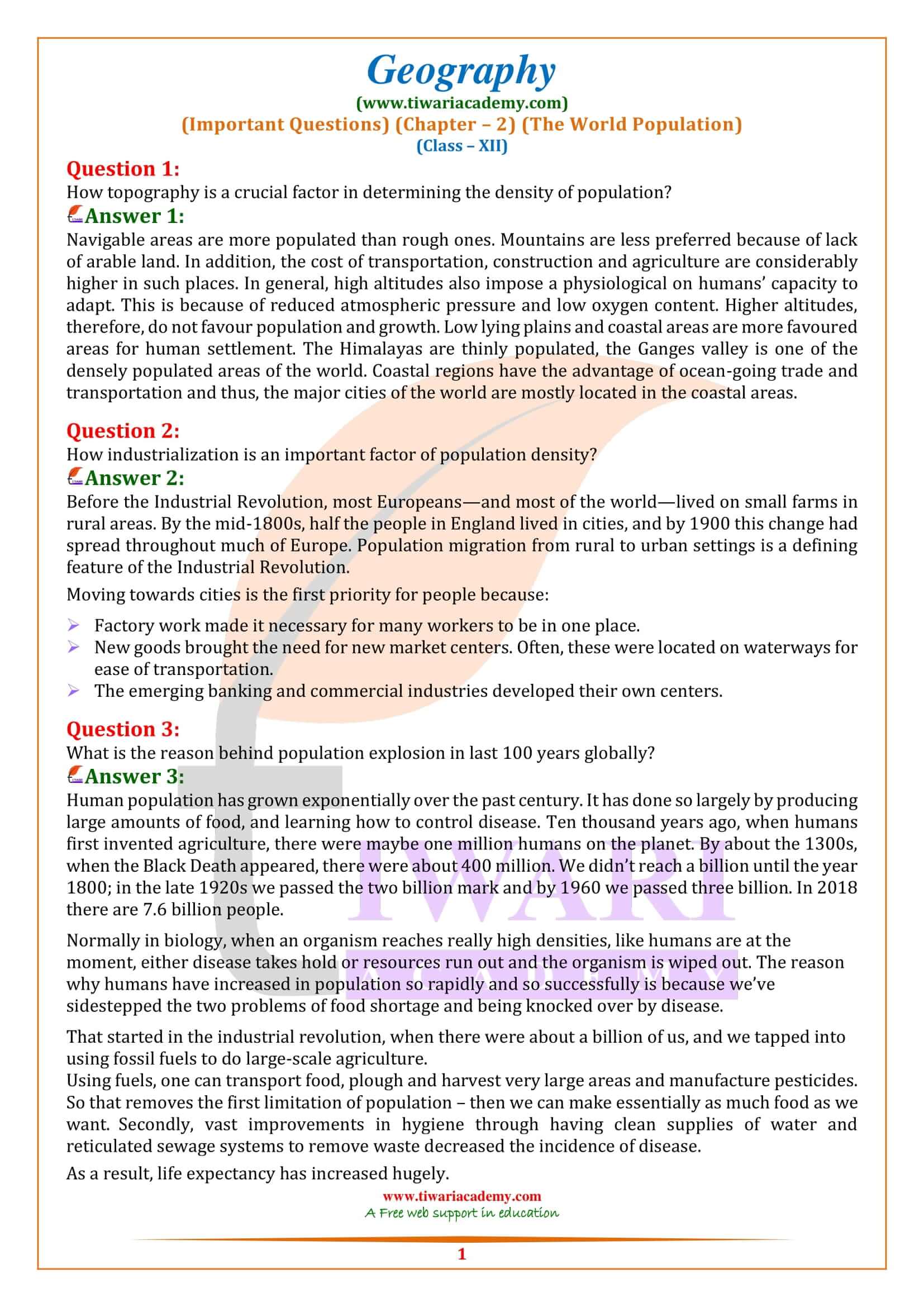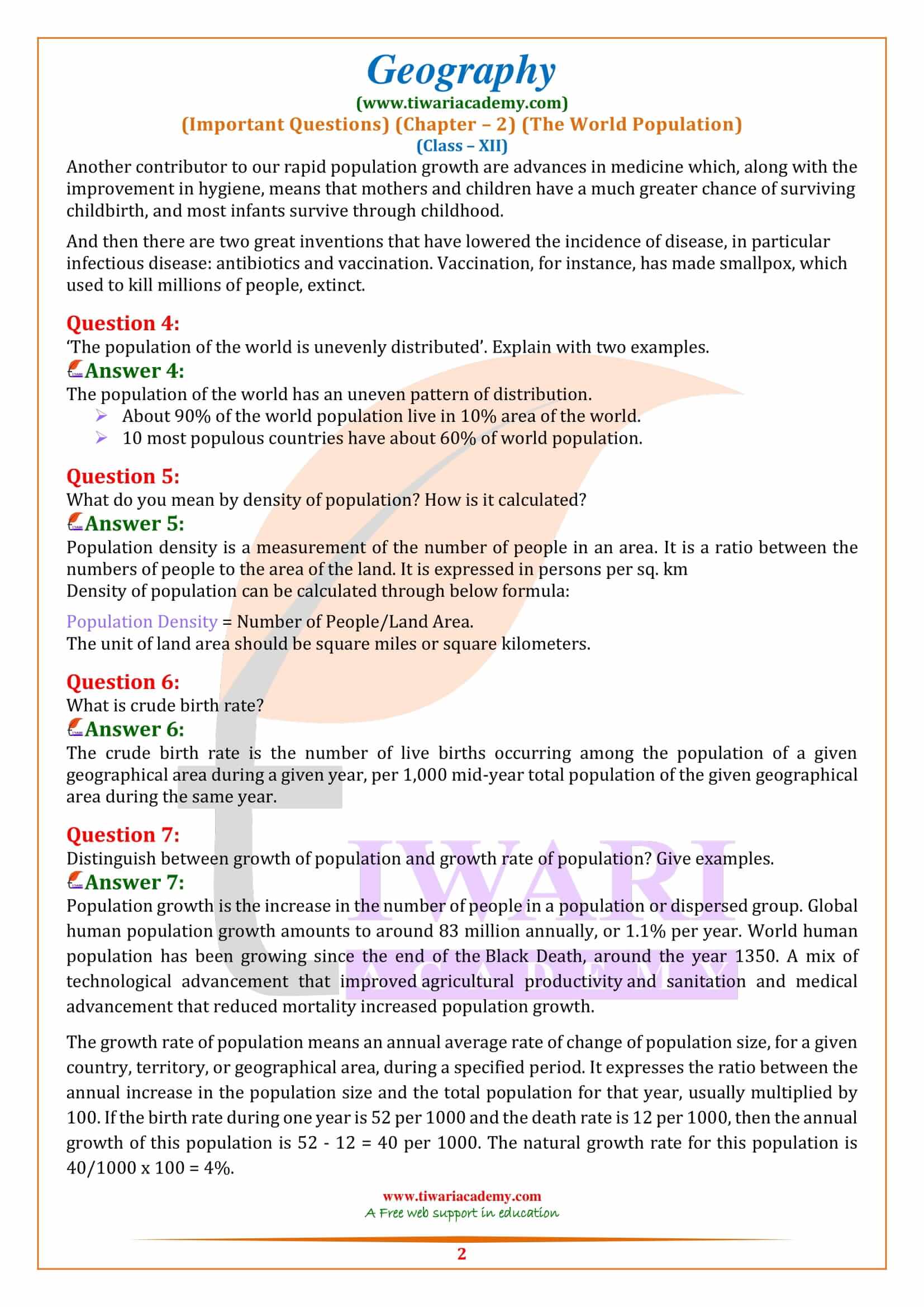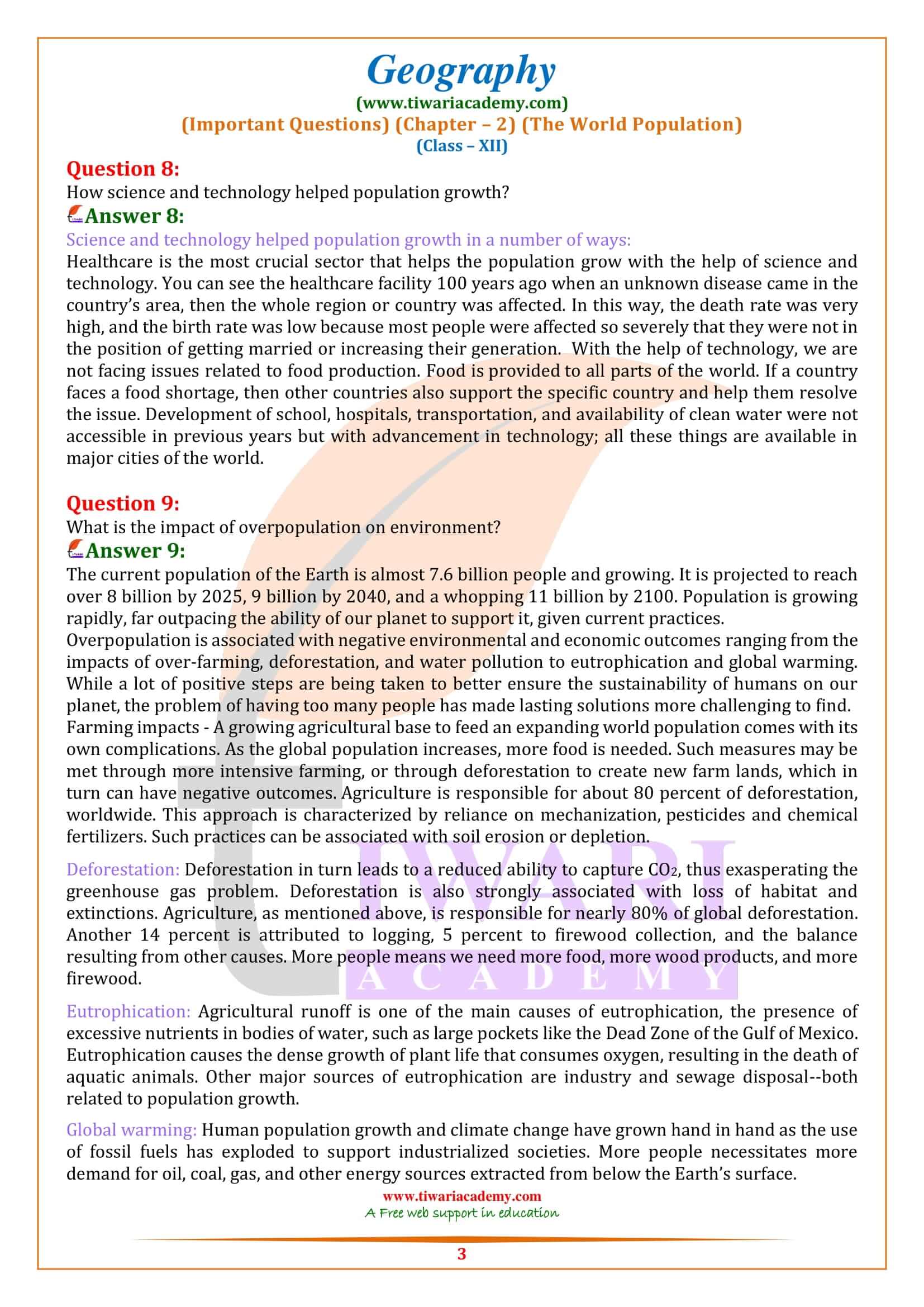NCERT Solutions for Class 12 Geography Chapter 2 Important Questions of The World Population Distribution, Density and Growth for CBSE 2024-25. Extra questions for exams of 12th Geography part 1 Fundamentals of Human Geography chapter 2 are helpful during the revision.
Class 12 Geography Chapter 2 Important Questions
Class 12 Geography Chapter 2 Important Extra Question Answers
How topography is a crucial factor in determining the density of population?
Navigable areas are more populated than rough ones. Mountains are less preferred because of lack of arable land. In addition, the cost of transportation, construction and agriculture are considerably higher in such places. In general, high altitudes also impose a physiological on humans’ capacity to adapt. This is because of reduced atmospheric pressure and low oxygen content. Higher altitudes, therefore, do not favour population and growth. Low lying plains and coastal areas are more favoured areas for human settlement. The Himalayas are thinly populated, the Ganges valley is one of the densely populated areas of the world. Coastal regions have the advantage of ocean-going trade and transportation and thus, the major cities of the world are mostly located in the coastal areas.
How industrialization is an important factor of population density?
Before the Industrial Revolution, most Europeans—and most of the world—lived on small farms in rural areas. By the mid-1800s, half the people in England lived in cities, and by 1900 this change had spread throughout much of Europe. Population migration from rural to urban settings is a defining feature of the Industrial Revolution.
Moving towards cities is the first priority for people because:
- Factory work made it necessary for many workers to be in one place.
- New goods brought the need for new market centers. Often, these were located on waterways for ease of transportation.
- The emerging banking and commercial industries developed their own centers.
What is the reason behind population explosion in last 100 years globally?
Human population has grown exponentially over the past century. It has done so largely by producing large amounts of food, and learning how to control disease. Ten thousand years ago, when humans first invented agriculture, there were maybe one million humans on the planet. By about the 1300s, when the Black Death appeared, there were about 400 million. We didn’t reach a billion until the year 1800; in the late 1920s we passed the two billion mark and by 1960 we passed three billion. In 2018 there are 7.6 billion people.
Normally in biology, when an organism reaches really high densities, like humans are at the moment, either disease takes hold or resources run out and the organism is wiped out. The reason why humans have increased in population so rapidly and so successfully is because we’ve sidestepped the two problems of food shortage and being knocked over by disease.
That started in the industrial revolution, when there were about a billion of us, and we tapped into using fossil fuels to do large-scale agriculture.
Using fuels, one can transport food, plough and harvest very large areas and manufacture pesticides. So that removes the first limitation of population – then we can make essentially as much food as we want. Secondly, vast improvements in hygiene through having clean supplies of water and reticulated sewage systems to remove waste decreased the incidence of disease.
As a result, life expectancy has increased hugely.
Another contributor to our rapid population growth are advances in medicine which, along with the improvement in hygiene, means that mothers and children have a much greater chance of surviving childbirth, and most infants survive through childhood.
And then there are two great inventions that have lowered the incidence of disease, in particular infectious disease: antibiotics and vaccination. Vaccination, for instance, has made smallpox, which used to kill millions of people, extinct.
How science and technology helped population growth?
Science and technology helped population growth in a number of ways:
Healthcare is the most crucial sector that helps the population grow with the help of science and technology. You can see the healthcare facility 100 years ago when an unknown disease came in the country’s area, then the whole region or country was affected. In this way, the death rate was very high, and the birth rate was low because most people were affected so severely that they were not in the position of getting married or increasing their generation.
With the help of technology, we are not facing issues related to food production. Food is provided to all parts of the world. If a country faces a food shortage, then other countries also support the specific country and help them resolve the issue. Development of school, hospitals, transportation, and availability of clean water were not accessible in previous years but with advancement in technology; all these things are available in major cities of the world.
What is the impact of overpopulation on environment?
The current population of the Earth is almost 7.6 billion people and growing. It is projected to reach over 8 billion by 2025, 9 billion by 2040, and a whopping 11 billion by 2100. Population is growing rapidly, far outpacing the ability of our planet to support it, given current practices. Overpopulation is associated with negative environmental and economic outcomes ranging from the impacts of over-farming, deforestation, and water pollution to eutrophication and global warming. While a lot of positive steps are being taken to better ensure the sustainability of humans on our planet, the problem of having too many people has made lasting solutions more challenging to find.
Farming impacts
A growing agricultural base to feed an expanding world population comes with its own complications. As the global population increases, more food is needed. Such measures may be met through more intensive farming, or through deforestation to create new farm lands, which in turn can have negative outcomes. Agriculture is responsible for about 80 percent of deforestation, worldwide. This approach is characterized by reliance on mechanization, pesticides and chemical fertilizers. Such practices can be associated with soil erosion or depletion.
Deforestation
Deforestation in turn leads to a reduced ability to capture CO2, thus exasperating the greenhouse gas problem. Deforestation is also strongly associated with loss of habitat and extinctions. Agriculture, as mentioned above, is responsible for nearly 80% of global deforestation. Another 14 percent is attributed to logging, 5 percent to firewood collection, and the balance resulting from other causes. More people means we need more food, more wood products, and more firewood.
Eutrophication
Agricultural runoff is one of the main causes of eutrophication, the presence of excessive nutrients in bodies of water, such as large pockets like the Dead Zone of the Gulf of Mexico. Eutrophication causes the dense growth of plant life that consumes oxygen, resulting in the death of aquatic animals. Other major sources of eutrophication are industry and sewage disposal–both related to population growth.
Global warming
Human population growth and climate change have grown hand in hand as the use of fossil fuels has exploded to support industrialized societies. More people necessitates more demand for oil, coal, gas, and other energy sources extracted from below the Earth’s surface.





